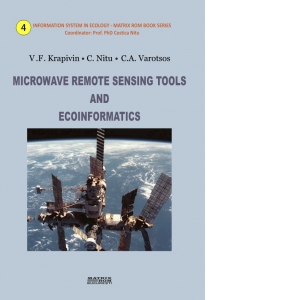Microwave remote sensing tools and ecoinformatics
de: Costica Nitu, Vladimir F. Krapivin, Costas A. Varotsos
Publicat de: Editura Matrixrom
Anunta-ma cand revine pe stoc!Summary
Preface
List of abbreviations and acronyms
List of parameters
1. Theoretical and applied basics in microwave radiometry
1.1. Introduction
1.2. Main concept of remote monitoring technology
1.3. Basic models of microwave emission from water and land surfaces
1.4. Remote-sensing research platforms and their equipment
2. Remote sensing technologies and data processing algorithms
2.1. Microwave methods
2.2. Physical, theoretical and experimental background of microwave
monitoring
2.3. Remote sensing technologies in the infrared and optical bands
2.4. The atmosphere microwave monitoring
2.5. Algorithms for remote data processing
2.6. An adaptive technology for the glassification and the qualitative
interpretation of the data of the remote sensing of the water surface
2.7. A device to measure the geophysical and hydrophysical parameters
2.8. Direct and inverse problems of microwave monitoring
2.9. Interferometry methods in the georisk assessment tasks
3. GIMS-based method of vegetation microwave monitoring
3.1. Introduction
3.2. Monitoring of soil-plant formations
3.3. Links between experiments, algorithms and models
3.4. Microwave model of vegetation cover
4. Microwave remote sensing of soil moisture for agricultural and hydrological
applications
4.1. Introduction
4.2. Practical microwave radiometric risk assessment of agricultural
function
4.3. Geoinformation monitoring system of agricultural function
4.4. Microwave monitoring of soil moisture
4.5. Basic parameters and indicators of the sate of soils and water objects
evaluated by means of radiometry methods
5. Vegetation screening effect in the remote sensing monitoring
5.1. Introduction
5.2. Vegetation media as an object in a study of attenuation of
electromagnetic waves
5.3. Measuring system for retrieving attenuation of microwaves in
vegetation
5.4. Experimental results
5.5. Theoretical generalization
5.6. Conclusion and discussion
6. Microwave tools for the diagnostics of forest fires
6.1. Introduction
6.2. Wildfires as a component af global ecodynamics
6.3. Microwave radiometric observations of temperature anomalies
6.4. Features of SHF-radiometric monitoring of wildfires
7. Space methods and monitoring tools for the investigation of aquatic systems
7.1. Introduction
7.2. Microwave radiometry in the remote monitoring of the ocean
7.3. Innovative Big Data aproach to the Arctic Basin pollution problem
7.4. Geocological information-modeling system and its implication for the
biocomplexity and survivability assessment of the Okhotsk Sea
ecosystem
7.5. The Peruvian Current ecosystem and ecoinformatics tools
7.6. Scenario for the water cycle stabilization in the Aral Sea region
7.7. Mathematical modelling and numerical experiment in the geophysical
study on the Aral Sea region
7.8. Simulation experiments and forecast of the water balance components
of the Aral Sea hollow
8. Global climate change problems
8.1. Introduction
8.2. Interactive character of global climate problems
8.3. Anthropogenic sources of carbon
8.4. Resources of the biosphere and the greenhouse effect
8.5. The greenhouse effect and global carbon cycle
8.6. Global climate and natural disasters
8.7. Reality and expected changes in the enviroment
8.8. The current needs for the ecological-climatic modeling
8.9. Climate, biosphere and society
References
| General | |
| Anul | 2019 |
| Autor | Costica Nitu, Vladimir F. Krapivin, Costas A. Varotsos |
| Categorii | Invatare Limbi Straine, Limba Engleza, Calculatoare / IT, Carti |
| Editura | Editura Matrixrom |
| ISBN | 9786062504861 |
| Limba | Engleza |






